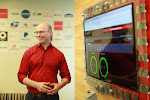I'm running Linux on my desktop at work after a year of OS X, and Gnome as shipped by Ubuntu 8.10 has just been a world of hurt. The panel looks and works like ass when moved to the left side of the screen (the only sane place to put it in today's world of widescreen monitors), network-manager just decided to quit working one day (I got by with wicd after that), alt-tab behavior sucks both ways you can configure it, etc.
I installed KDE 4.2 over the weekend to see if I was missing anything there.
Wow.
It's like daylight after being in a cave for two months. I didn't realize how hard it has been to use a butt-ugly environment until I wasn't anymore. (Yes, I tried all the gnome themes I could find. Even Nimbus which took a bit of work. What's that recently-famous phrase? "Lipstick on a pig?")
What is better in KDE? In a word, everything. And put me in the camp that really likes having the desktop turned into a usable area for the first time. Like apple's dashboard, except it doesn't suck. I always hated dashboard.
Things that could be improved:
- Never in a thousand years would I have thought to look under "Regional & Language" for the preference to turn caps lock into control. I had to google this.
- I'm still not sure how to set F9 to Present Windows. Or how to bind a keystroke to the K menu as a poor man's quicksilver.
- More generally, a "Welcome to kde. Let me teach you how to be a power user" tutorial would be nice. I have the feeling there is lots of awesome under the hood if I knew where it was. I never got that feeling from gnome. ("Beauty is only skin deep, but ugly goes right to the bone.")
- Firefox UI widgets are imperfectly themed from XUL to GTK to KDE. But it is useable. (And having my second monitor redraw correctly instead of leaving artifacts when windows are moved makes up for that.) Is this KDE's fault? Firefox's? I don't know.
- Konqueror is still using KHTML instead of webkit which means it is mostly unusable in the world of "web 2.0." Yes, you can install webkitkde but that is Very Alpha. ("Open in new window" doesn't work, for instance. "Open in new tab" is gone entirely.)
- I couldn't find an option to just use icons in the task manager widget.

Comments
If you want quicksilver, try katapult.
Theming is a pain. Usually distros take care of the easy stuff, but trying to get emacs/qt/gtk+/OOo/java all looking consistent is a lost cause. I'll try and get the fonts to be somewhat consistent, but I don't have the time nor inclination to mess with themes.
Funny you should mention khtml since it is the granddaddy of webkit. Too bad apples fork happened in a pre-git world when forking/merging was painful....
cheers
Still not sure how to add a shortcut to Present Windows if I don't want it to be the alt-tab behavior.
THANK YOU. People look at me like I'm crazy.
What howto did you follow for installing it?
Also, how do multiple virtual desktops work? And is there any replacement for compiz "place windows"? These are both utterly indespensible in my gnome environment.
Virtual desktops seem more or less the same as everywhere since 1994 or so. :)
I'm not familiar with Place Windows, sorry.
Right click on window title -> Configure Window Behavior -> Desktop Effects -> All Effects (tab). Scroll to present windows and click the wrench icon. In the bottom section click on Toggle Present Icons and then set a custom shortcut.
I don't know if this is what compiz has but there are different placement options under Advanced->Placement (my default is smart but I've never played with it).
It should be noted that place windows is pretty buggy, as lots of apps don't obey it or obey it oddly (some dialogs go to the right desktop while the main app just opens wherever you are, for example).
Is that what Advanced>Placement can do in KDE4.2? move a particular application to a virtual desktop and maximize it?
Your blog and all but did you really have to insult half your fellow linux users? Despite the wonderful gimmicks I found Gnome more usable than KDE3.5 I'll give a try to KDE again when it gets more apps and stability.
> moved to the left side of
> the screen (the only sane place to
> put it in today's world of widescreen
> monitors
oh no, next you are going to suggest...
> I couldn't find an option to just
> use icons in the task manager widget
there you go. That's terrible usability,
I had my window list buttons expand to fill the bottom of the screen, too bad Gnome removed that functionality.
Desktop > Window-Specific Settings > New... > Geometry [Tab] > Desktop [Item]
You have to choose a window to configure in the Window tab; the Detect button is very useful.
I believe this is a feature of the KWin window manager part of KDE. It's probably in KDE4 as well, since I don't think they had many features removed in the kwin component when they changed to KDE4.
KWin has a ton of features, which you can see by the huge number of options in this advanced configuration dialog.